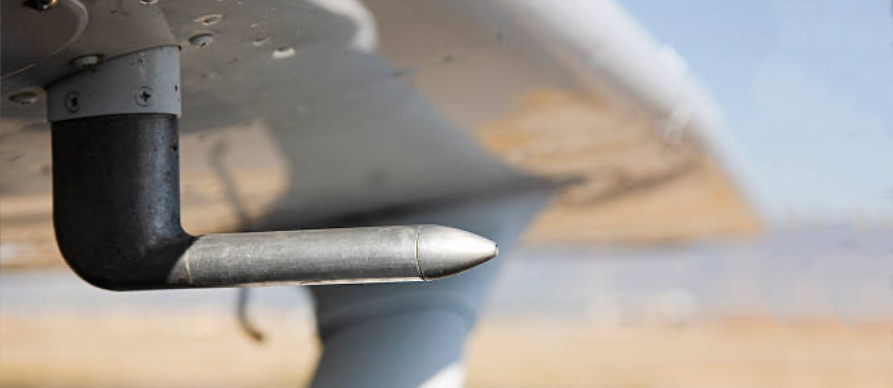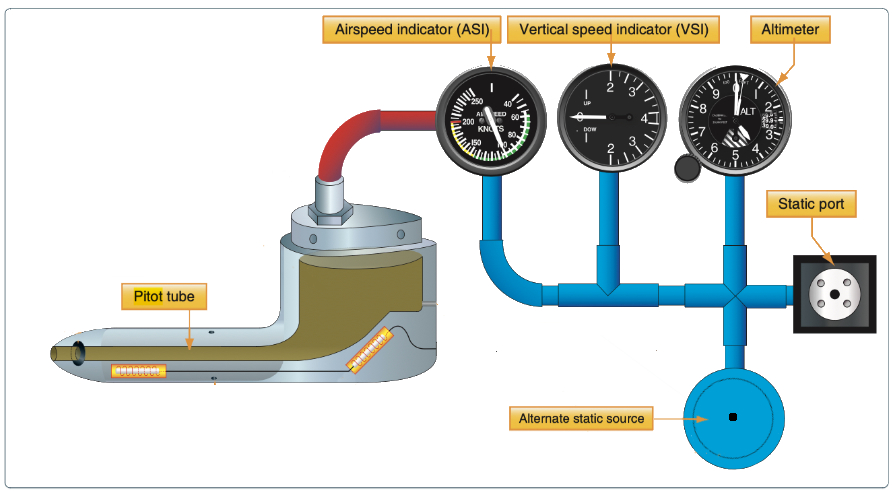
The pitot-static system is a critical component in aviation providing pilots with essential data for safe and accurate flying.
The pitot static system in aircraft is used to measure three critical parameters:
- Airspeed
- Altitude
- Vertical speed
These measurements are crucial for safe flight operations. The system consists of two primary elements: the pitot tube and the static port.
In order to safely fly any aircraft, a pilot must understand how to interpret and operate the flight instruments. The pilot also needs to be able to recognize associated errors and malfunctions of these instruments.
The Pitot Static Components
The pitot-static system is made up of the following key components
- Pitot Tube: Measures dynamic pressure (caused by the aircraft’s forward motion through the air). Usually mounted on the wing or the nose of the aircraft. The Pitot tube captures air directly in the flight path, channeling it into the system to provide readings for airspeed.
- Static Port: Measures static pressure (ambient atmospheric pressure). Typically located on the fuselage in an area with minimal airflow disturbance. Provides the static pressure component used in multiple instruments, ensuring accurate readings of altitude and airspeed
- Associated Instruments: The pitot-static system feeds data to several key flight instruments:
- Airspeed Indicator: Combines dynamic pressure from the pitot tube and static pressure from the static port. Displays the aircraft’s speed relative to the surrounding air.
- Altimeter: Uses static pressure to calculate altitude above mean sea level (MSL).
- Vertical Speed Indicator (VSI): Measures the rate of change in static pressure to determine the aircraft’s rate of climb or descent.
- Drain Valves: Remove water or moisture that may collect in the system. Found in low points of the system, near the pitot tube or static lines.
- Heater (Optional) Prevents ice buildup in the pitot tube, which could block airflow and lead to inaccurate readings. Built into the pitot tube, activated as needed in cold or icing conditions.
- Interconnecting Lines: Transmit pressures from the pitot tube and static port to the instruments. Typically made of flexible tubing or rigid metal lines to ensure durability and pressure integrity.
- Alternate Static Source (Optional) Provides a backup static pressure source in case the primary static port is blocked. Often located inside the cockpit.

Pitot-Static Flight Instruments
The pitot-static system is a combined system that utilizes the static air pressure and the dynamic pressure due to the motion of the aircraft through the air.
These combined pressures are utilized for the operation of:
Airspeed Indicator (ASI)

Measures the difference between the dynamic pressure from the pitot tube and the static pressure from the static port to calculate the aircraft’s airspeed.
The air speed indicator is also connected to the static system vent like so but in addition to sensing the calm air from the static system vent the air speed indicator is connected to the ram air from the pitot tube and it’s connected right to the air speed indicator (red tube in diagram).
The pitot tube has a small opening at the front that allows the total pressure to enter the pressure chamber. The total pressure is made up of dynamic pressure plus static pressure.
In addition to the opening in the front of the pitot tube, there is a small hole in the back of the chamber that allows moisture to drain from the system should the aircraft enter precipitation conditions in flight. Both openings in the pitot tube must be checked prior to flight to ensure that neither is blocked.
The ram air from the pitot tube enters the hole at an increased pressure because it is exposed to the air in the front of the pitot tube. This is why the pitot tube is somewhere where the air will ram into it – usually underneath the wing.
When you have this impact pressure from the pitot tube it is then piped to the air speed indicator instrument.
The air speed indicator measures the difference between the air pressure from the ram air from the pitot tube and the air from the static system port and it compares the difference between the two and that difference is your air speed indication.
Vertical Speed indicator Indicator (VSI)

Measures the rate of change in static pressure over time to display the aircraft’s rate of climb or descent.
The vertical speed indicator is connected to the static port in the calm air and as you go to higher or lower altitudes the pressure changes as you know the air pressure changes. The vertical speed indicator is basically a box with a hole in it and as you go to higher altitudes for instance the air wants to rush out of that hole through the static system vent and the vertical speed indicator simply measures the speed at which the air rushes in and out of that hole and gives you your rate of climb or descent.
Altimeter

Uses the static pressure to determine the aircraft’s altitude above sea level.
The altimeter simply measures the air pressure, the calm air pressure, outside the aircraft and then the hands tell you the air pressure calibrated in thousands of feet above sea level. The altimeter, is really just an air pressure measuring device that gives its answer in thousands of feet above sea level.
All three of these instruments are connected to the static system ports. The static port is on the outside the aircraft – the blue port represents the alternate static port which is inside the aircraft.
The static ports sense the calm air (also known as ambient pressure) outside the aircraft. They’re normally located somewhere outside of the slipstream effect and outside of the ram effect. These ports are basically holes in the aircraft that are connected by that plastic tubing to all three of those instruments. The blue tubes represent the tubing and are inside the aircraft.
The static port is connected to all three of the instruments. The holes (ports) for the static system have to be in undisturbed air outside the aircraft.
Common Issues:
- Blockages: If the pitot tube or static port becomes blocked by debris, ice, or insects, the readings provided by the instruments can be incorrect.
Pitot Tube
- A pitot tube cover can prevent insects from building nests and blocking the pitot tube.
- A blockage in flight caused by ice build up on the pitot tube can be remedied by turning on pitot which melts the ice.
- A blocked pitot tube can cause the airspeed indicator to show incorrect speeds.
Static Port
If the static system port is clogged the Airspeed Indicator, Vertical Speed Indicator and the Altimeter which are connected to the static port, would be affected.
Pitot Tube & Static Port
If both the Pitot Tube and the Static Ports are clogged, which instruments would be affected?
If both the pitot tube and the static system port is clogged the Airspeed Indicator, Vertical Speed Indicator and the Altimeter which are connected to the static port, would be affected.
Leaks
- Leaks: Any leaks in the pitot-static system can also result in inaccurate instrument readings, potentially compromising flight safety.
For more information see PHAK 8-1